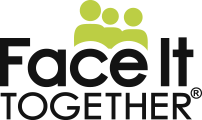Data drop: Employment impacts for persons with addiction
March 8, 2022
This month’s data drop is 77%.
Since 2016, Face It TOGETHER has gathered information about our members’ employment through the collection of output- and outcome-related data. From Jan. 1, 2016 to Feb. 12, 2022, Face It TOGETHER collected 1,615 intake forms from persons struggling with alcohol and other drugs. Face It TOGETHER also collected follow-up information, requested every 30 days during engagement, from 708 members. Most of those members (77.1%) expressed some type of employment concerns at intake.
Most members included in this analysis (63.7% out of 708) were employed at either a full- or part-time level when they first become engaged with Face It TOGETHER. Employment was most prevalent in the following industries: restaurant and hospitality (11.7%), construction and manufacturing (11.0%), healthcare (9.8%), retail (6.7%) and education (4.9%).
Face It TOGETHER doesn’t focus on sobriety, which is the typical measurement for addiction wellness. Instead, we consider our members’ social, personal and cultural capital using our Recovery Capital Index (RCI) and the risk factors that may impede wellness through our Risk Assessment (RA). Employment is one of many areas that becomes the focus of peer coaching sessions.
Jeff, a coaching member in Sioux Falls, SD, noticed several changes in his work performance after getting well from alcohol addiction.
“I’m just much happier; I think I’m probably a better leader to my team, you know that humility and that vulnerability," he said. "I listen to them, I think I’m more caring, I think I’m better with my clients. I’m sharper for sure.”
Since 2016, the 708 individuals part of this analysis on average scored below 50% of the total score available at their intake for employment-related metrics. After at least 30 days of peer coaching, more than half (57.2%) improved scores in metrics related to employment. These employment metrics, collected at baseline and every 30 days of engagement, focus on impacts to employment, satisfaction, employer support, transportation and clothing-related issues.
At intake, 68.5% of members indicated transportation issues were impacting their ability to get to work and 12.0% were concerned about the clothing they had for work. In addition to helping members address their stress related to these issues, peer coaches also provide referrals to organizations that offer additional support and resources. After participating in coaching, many members are less likely to be worried about their transportation (44.8% after four months) and clothing (72.2% after two months) for work.


Employment satisfaction can be dependent on a number of factors (e.g., being unemployed, income, stress-levels, lack of challenge, supervisory or peer-related conflicts, etc.). At intake, 46.3% are unsatisfied with their employment. There are many ways that peer coaches work with members who are struggling with this, including assisting in resume development and/or connecting members to job seeking resources. In addition, peer coaches help members overcome potential issues they are experiencing at work, such as supervisor conflict or levels of stress. After four months of coaching, 60.3% of members report improvement in their employment satisfaction.

Members are also impacted by their workplace’s environment as it relates to addiction wellness or general wellbeing. A non-supportive environment can make it difficult for a member to seek help and/or to make positive changes in their general health. At intake, 58.2% indicated their workplace was not supportive in their addiction wellness. While peer coaches may not be able to directly impact a workplace environment, they help members explore ways to change their employment and/or provide resources for co-workers when appropriate. A third (31.0%) of members are less impacted by a non-supportive workplace environment after participating in coaching for two months.

Employment can often be negatively impacted by addiction-related issues (e.g., absenteeism, loss of efficiency, poor decision making, etc.). At intake, 22.4% of members recognized addiction had a negative impact on their employment. After at least 30 days of peer coaching, most (78.7%) of those members were no longer impacted by these negative issues. There are many ways that peer coaches support members in this area, including harm reduction and communication strengthening, setting achievable goals for the week (e.g., making it to work on time) and improving their sleeping habits.

Nationally, we know at least 70% of those with alcohol and other drug addiction are employed. Member employment-related issues are one of the many critical areas that our peer coaches focus on during their time with members.
Kai, a coaching member in Sioux Falls, SD, started feeling better in all aspects of his life including work after a few months of addiction wellness.
“I could feel myself just coming a little bit more alive. The day I came in here (to Face It TOGETHER), I was an engine running on very low oil, and now it's like now I’m firing on all eight cylinders,” he said. “I’ve started to feel not only a sense of accomplishment, but a sense that I can face things better, I can go through things better.”
This knowledge discovery process provides valuable information for Face It TOGETHER. We use insights like those highlighted here to continually improve our peer coaching program, including the identification of training needs for coaches and additional programming for members. Our goal is to set members up for success in their wellness in whatever ways are most important to them.
